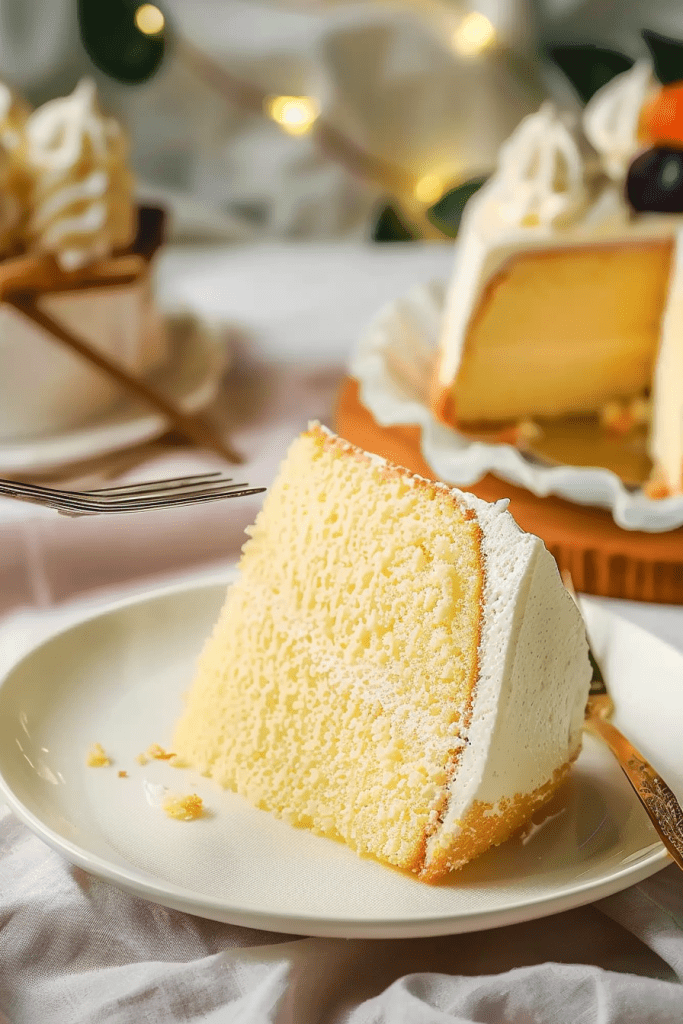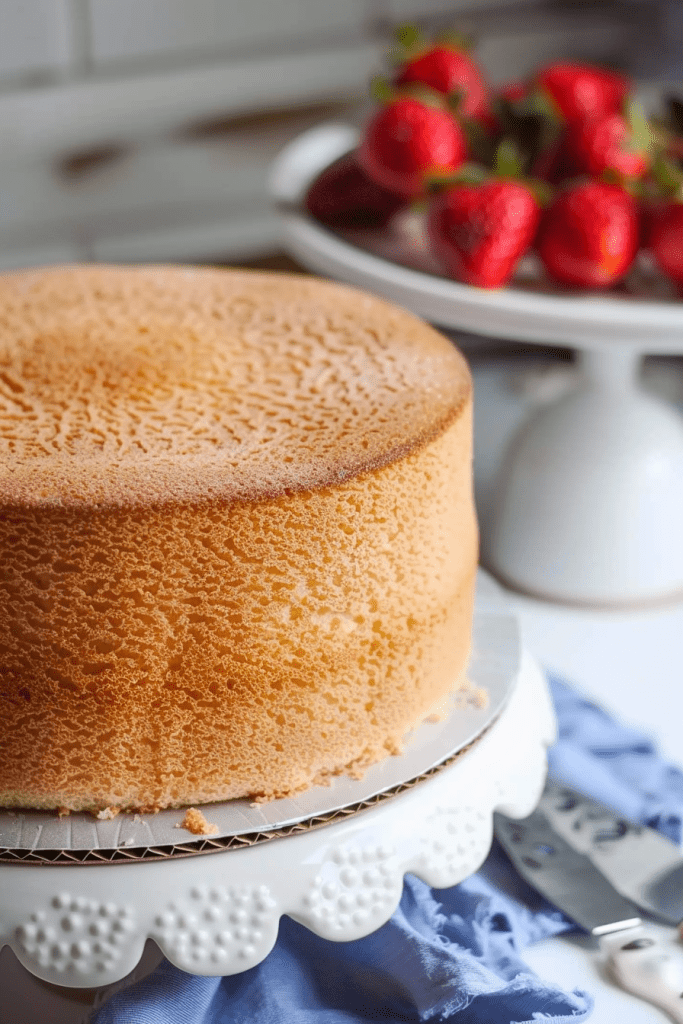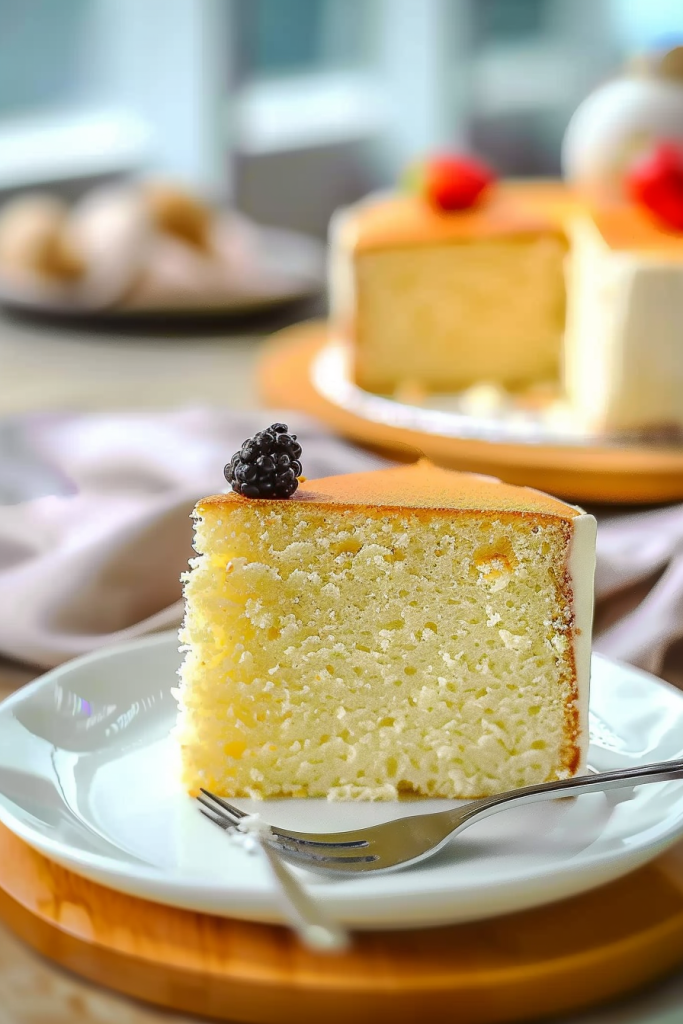Being a seasoned food blogger, I’ve come to appreciate the importance of a versatile vanilla sponge cake recipe in every baker’s collection. This classic treat serves as a perfect base for a myriad of flavors, making it a staple in the world of baking. After much experimentation and fine-tuning, I’ve crafted a vanilla sponge cake recipe that boasts a velvety, tender crumb and a light, airy texture that’s simply irresistible.

Choosing the Right Ingredients
When it comes to creating the perfect vanilla sponge cake, selecting the right ingredients is key to achieving a light, airy, and flavorful cake that will be a hit with your guests.
Flour Options
For a super tender crumb, using cake flour can elevate the texture of your vanilla sponge cake. Cake flour has a lower protein content than all-purpose flour, resulting in a softer and more delicate cake. If you don’t have cake flour on hand, you can easily make your own by adding cornstarch to all-purpose flour.
Sugar and Sweeteners
Choosing the right sweetener is crucial in achieving the ideal sweetness and texture in your vanilla sponge cake. Castor sugar, also known as superfine sugar, dissolves easily, making it perfect for creaming with butter to create a light and fluffy texture. Its finer crystals also contribute to a smoother batter, resulting in a more uniform cake.
Essential Flavorings
Incorporating the right flavorings is essential to enhance the taste of your vanilla sponge cake. Vanilla essence or extract is a must for that classic vanilla flavor. Make sure to use a good quality vanilla extract to infuse your cake with a rich and aromatic vanilla taste. Additionally, adding a touch of salt can help balance the sweetness and elevate the overall flavor profile of your cake.
Equipment and Tools Needed
To create the perfect vanilla sponge cake, it’s essential to have the right equipment and tools at hand. Here’s a list of the key items you’ll need to make your baking experience smooth and stress-free:
- Hand Mixer: A reliable hand mixer is a must-have for this recipe. It doesn’t need to be fancy; a basic hand mixer will do the job perfectly. I’ve been using mine for almost 9 years now, and it has never let me down.
- Mixing Bowl: A sturdy mixing bowl is essential for combining all the ingredients efficiently. You don’t need anything fancy; a simple mixing bowl like the one I’ve been using for 8 years will work just fine.
- Kitchen Timer: Timing is crucial when baking a cake. Make sure you have a kitchen timer to ensure that your cake is baked to perfection. If you don’t have a kitchen timer, your phone’s timer will work just as well.
- Cake Tins: You’ll need two 8-inch cake tins for this recipe. If you’re just starting out, stick to basic cake tins to keep things simple. Ensure that your cake tins are properly greased to prevent sticking.
- Spatula: A good spatula is essential for scraping every bit of batter into the cake tin. Say no to food waste by using a spatula to ensure you get every last drop of batter into the tin.
Having these essential tools and equipment on hand will make the process of baking a delicious vanilla sponge cake much more enjoyable and successful.

Step-by-Step Instructions for Vanilla Sponge Cake
Preparing the Batter
After preheating the oven to 350°F (175°C), prepare the cake pans by buttering and lining the base with parchment paper. Cream together 1 1/2 cups (300g) granulated sugar and 1 cup (226g) softened unsalted butter until light and fluffy. Add in 4 large eggs, one at a time, ensuring each is fully incorporated before adding the next. Stir in 1 tablespoon of vanilla extract for a fragrant touch.
In a separate bowl, whisk together 3 cups (375g) cake flour, 1 tablespoon baking powder, and 1/2 teaspoon salt. Using a spatula, hand-mix the dry ingredients into the butter mixture alternately with 1 1/4 cups (300ml) buttermilk. Begin and end with the flour mixture, and mix until just combined; avoid overmixing to maintain a light texture.
Evenly divide the batter among the prepared cake pans and bake for 30-35 minutes until the cakes spring back to the touch. A toothpick inserted into the center should come out mostly clean, indicating the cakes are baked through.
Baking the Cake
Pour the prepared sponge cake batter into the cake pans and place them in the preheated oven. Bake the cakes at 350°F (175°C) for 30-35 minutes, checking for doneness by gently pressing the surface – it should spring back when lightly touched. Once baked, a toothpick inserted into the center should come out with a few moist crumbs but no wet batter, signaling the cakes are ready.
If the tops of the cakes are browning too quickly, cover them with foil to prevent further browning. After baking, allow the cakes to cool in the pans for 5 minutes before transferring them to a cooling rack to cool completely. Use caution when handling hot pans – a kitchen towel can be helpful in this step to avoid burns.
Cooling and Demolding
After baking, let the cakes cool in the pans for about 5 minutes to firm up. Gently invert the cakes onto a cooling rack and remove the parchment paper. Once they have cooled to lukewarm, wrap the cakes in plastic wrap and let them cool completely at room temperature.
Following the steps outlined above will result in a delicious vanilla sponge cake that is light, fluffy, and perfect for any occasion. Enjoy the process of creating this versatile cake that can be customized with various fillings and frostings to suit your taste preferences.

Variations and Flavor Additions
Incorporating Fruit Flavors
For a refreshing twist, consider incorporating different fruit flavors into your vanilla sponge cake. You can add diced strawberries, blueberries, or raspberries to the batter before baking. Alternatively, you can layer your cake with sliced bananas, peaches, or mixed berries for a fruity burst in every bite.
Chocolate Twist
For chocolate lovers, a chocolate twist can take your vanilla sponge cake to the next level. Simply mix cocoa powder into a portion of the batter to create a marbled effect or chocolate swirls throughout the cake. You can also add chocolate chips or ganache between the layers for a decadent and rich chocolate addition to your classic vanilla sponge cake.
Tips for Perfect Texture and Fluffiness
To ensure your vanilla sponge cake turns out light, fluffy, and absolutely delicious, here are some essential tips to keep in mind:
Proper Mixing Technique:
When combining the ingredients, it’s crucial to cream the butter and sugar adequately. Creaming helps incorporate air into the mixture, resulting in a lighter texture. Make sure to beat the butter and sugar until the mixture is pale and fluffy before adding other ingredients.
Room Temperature Ingredients:
To achieve the perfect texture in your vanilla sponge cake, make sure all your ingredients, especially the eggs and butter, are at room temperature. Room temperature ingredients blend more easily, creating a smoother batter that bakes up with a uniform crumb structure.
Gentle Folding Method:
When adding the dry ingredients to the wet ingredients, use a gentle folding motion. Overmixing can lead to a tough cake with a dense texture. Fold the dry ingredients into the wet mixture until just combined to maintain the airiness of the batter.
Precise Baking Time:
Baking the cake for the correct amount of time is crucial for achieving the desired texture. Overbaking can result in a dry cake, while underbaking will lead to a dense, gooey texture. Follow the recipe guidelines closely and perform the toothpick test to check for doneness.
Cooling and Storage:
After baking, allow the cake to cool in the pan for a few minutes before transferring it to a wire rack to cool completely. Proper cooling helps set the cake’s structure and prevents it from becoming dense. Store the cake in an airtight container at room temperature to maintain its freshness and fluffy texture.
By following these tips, you’ll be able to master the art of creating a light, airy, and flawless vanilla sponge cake every time.

Decorating Your Vanilla Sponge Cake
Decorating a vanilla sponge cake is the ultimate opportunity to get creative and elevate the visual appeal of your delicious creation.
Simple Frosting Techniques
To give your vanilla sponge cake a simple yet elegant look, consider using a classic buttercream frosting. Start by whipping softened butter until creamy, then gradually add powdered sugar and a splash of vanilla extract. Continue mixing until smooth and fluffy. For a pop of color, you can divide the frosting and add food coloring to create different shades. Use a palette knife to frost the cake evenly, or experiment with piping tips to create decorative swirls and patterns.
Decorative Ideas
For a more elaborate decoration, you can explore various decorative ideas to make your vanilla sponge cake truly special. Consider topping the cake with fresh fruit like strawberries, blueberries, or raspberries for a burst of color and flavor. Edible flowers, chocolate shavings, or toasted nuts can also add a touch of sophistication to your cake. If you’re feeling adventurous, try your hand at intricate fondant decorations or edible metallic accents for a show-stopping finish. Remember, the key is to have fun and let your creativity shine through in your cake decoration.

Storage and Freshness Tips
After baking a delicious vanilla sponge cake, it’s essential to store it properly to maintain its freshness and texture. Here are some tips to ensure your cake stays moist and delicious for as long as possible:
1. Proper Storage:
- Once the vanilla sponge cake has completely cooled, store it in an airtight container or wrap it tightly in plastic wrap to prevent it from drying out.
- Avoid storing the cake in the refrigerator as it can make the cake dry. Instead, keep it at room temperature in a cool, dry place.
2. Freezing:
- If you want to freeze the cake for later use, make sure it is completely cooled before wrapping it in several layers of plastic wrap.
- Place the wrapped cake in a freezer-safe container or a resealable plastic bag to prevent freezer burn.
- When ready to enjoy the frozen cake, let it thaw in the refrigerator overnight for the best texture.
- To keep the cake fresh for longer, consider adding a simple syrup brushing before storing. This can help retain moisture and add an extra layer of flavor.
- For a decorative touch, sprinkle some powdered sugar on top of the cake just before serving to freshen up its appearance.
By following these storage and freshness tips, you can enjoy your delicious vanilla sponge cake for days to come, maintaining its taste and texture.

Conclusion
Having a reliable vanilla sponge cake recipe is the key to unlocking a world of delicious possibilities. From mastering the creaming technique to exploring various flavor combinations, this versatile recipe serves as a canvas for your creativity. By following the detailed instructions provided, you can achieve a light and fluffy texture that will impress your taste buds. Remember, the secret lies in the proper mixing, baking, and decorating techniques outlined in this article. Whether you prefer a classic vanilla flavor or want to experiment with fruity additions, this recipe offers endless opportunities for customization. So, roll up your sleeves, preheat your oven, and let your imagination run wild with your next vanilla sponge cake creation.
